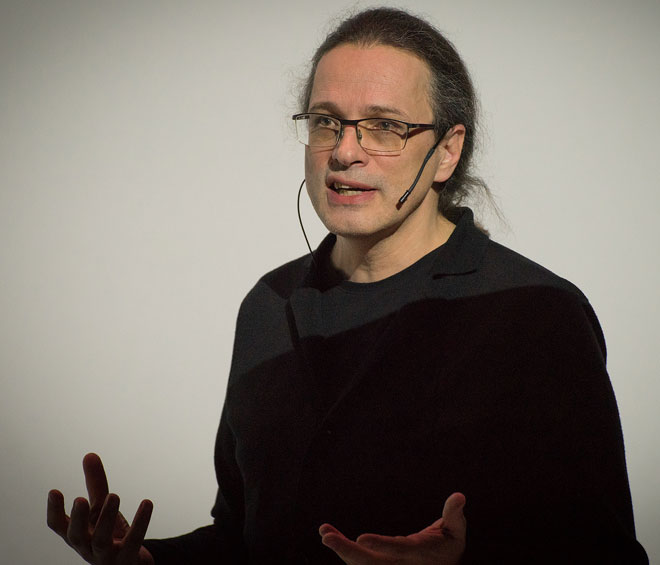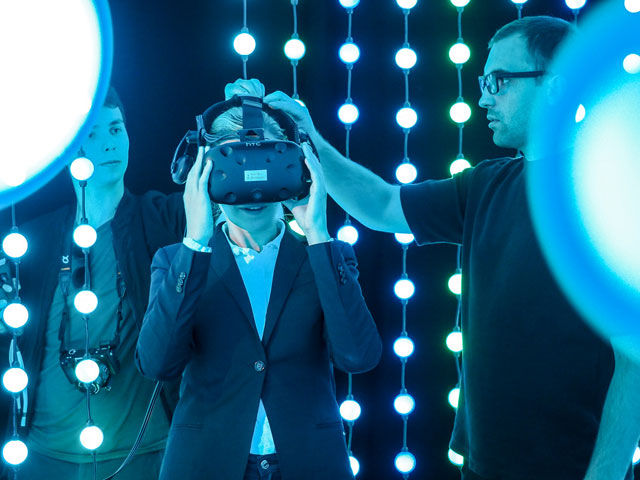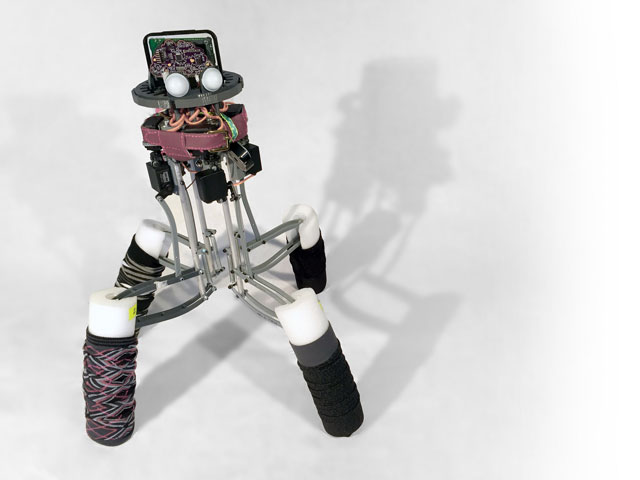
by CAROLINE MENEZES
Under the title AI – The Other I, the Ars Electronica Festival this year places artificial intelligence under the spotlight. It discusses the current progress in different areas of this still sometimes slightly feared subject. The idea is to present the segments of artificial intelligence that are already part of our daily life, such as deep learning or autonomous robots, to reflect on them and try to anticipate their impact on society. The programme features more than 500 events that bring together 1,000 participants, including artists, scientists, technology experts, educators and researchers. Until 11 September, there are exhibitions, performances, concerts, film-screenings, artistic interventions, symposiums and workshops taking place in more than 10 locations in Linz, Austria, including Post City, Lentos Art Museum, the OK Centre for Contemporary Art and the University of Art and Design Linz.

The VRLab in the Ars Electronica Centre’s Main Gallery showcases the latest VR, AR and MR technologies. In addition to applications by filmmakers and animators as well as artistic approaches, the VRLab relates the history of virtual and augmented reality’s development. Photograph: Ars Electronica / Martin Hieslmair.
Since the festival’s inception in 1979, people from all around the world have been going to Linz for the five-day event, which transforms the city – designated a Unesco City of Media Arts – into a meeting point for those interested in knowing what the future will bring. For media artists, in particular, it is a place where communities can come together to discuss new trends. With this in mind, a special section named Art Market Initiative has been added to this 2017 edition. It will invite gallerists and curators to create a network and make contact with the multitude of media artists who go to the festival each year to exchange ideas with their peers.
In the 1980s, Austrian artist Gerfried Stocker (b1964) was among those who used to go to Ars Electronica to meet others who, like him, were working with art and technology. Then, in 1995, Stocker became artistic director of Ars Electronica, taking on the job previously held by fellow Austrian artist Peter Weibel, a pioneer in the field who had turned the festival into one the most important in the world. Stocker, in turn, expanded the scope of Ars Electronica, developing the permanent operation of the Ars Electronica Centre, and launching other initiatives such as the Futurelab, a transdisciplinary research laboratory and atelier for projects involving industry or small enterprises.

Sarah Petkus. The Wandering Artist is a meditation that took place at the European Space Agency on the role that creativity and human expression play in the context of space exploration. A robotic entity was equipped to interact with its environment in personally expressive ways as a catalyst to encourage reflection from scientists and engineers about the purpose and identity of space-faring technology. This project is presented in the framework of the European Digital Art and Science Network and co-funded by the Creative Europe program of the European Union. Photograph: Sarah Petkus
Stocker talked to Studio International about going from being a media artist influenced by Ars Electronica to becoming the mind behind its organisation. He also describes the ways in which he ensures the festival is always exciting and up to date, and how to communicate relevant and unknown topics to the general public. He explains how the combination of art, technology and society, the pillars of Ars Electronica, went from being a difficult task to manage, to becoming an important legacy.
Caroline Menezes: For more than 20 years, you have been the artistic director of Ars Electronica, a platform that always presents topics relevant to the moment we are living in. How do you manage to keep the festival up to date? And within this question, I am curious to know when you first attended the festival, and what caught your attention and how it influenced your practice as an artist directly.
Gerfried Stocker: Where should I begin? Perhaps with the sentimental one? I first encountered Ars Electronica when I was boy living in a small village in Styria, in the Austrian countryside. I heard on the radio about a festival in Linz, dealing with new technologies and holding spectacular open-air events. I still remember it because it was a kind of an awakening. I had this idea that, once I became older, I wanted to see it for myself. The first time I went to Ars Electronica Festival was in 1986. It was mind-blowing. By this time, I was already working in the field of media art. I was about to leave university and live as an independent artist. I was full of doubts about whether this direction was really one I could take. In Ars Electronica, I saw many artists from all over the world working in this precise direction, combining new technologies and artistic expression. This was a real turning point in my life: to forget academia and pursue my way of developing ideas. Since then, I have attended every year to “inhale” all these great new things. In 1987, the Prix Ars Electronica started and I applied. Of course, I did not get a prize, but just knowing that there was a prize and that I could participate was very exciting, and the feeling that you were supported and were not alone was important.
CM: Which project did you apply for the first time? When did you finally get a prize, and what changed for you?
GS: It was composed of computer and analogic sounds with a very simple synchronised computer visualisation. Then, in 1991, I started an artist-run laboratory in Graz, called x-space, with Horst Hörtner (now the director of Ars Electronica Futurelab). It was a place where we could not only make our own art projects, but also work for artists who needed our technical skills. Horst was a superb software developer, and I was quite good at developing hardware. Working together, we got our first honourable mention at Prix in 1993, and in the following year we got a distinction. Perhaps, more than nowadays, getting a recognition at the Prix Arts Electronica, in this period, represented being accepted by the international media art “club”.
In 1995, I was coordinating a big radio and internet project for the Kunsthalle Wien. Hannes Leopoldseder, one of the founders of Ars Electronica, told me they were looking for a director for the Ars Electronica Centre, which was still under construction, and said he would be happy if I applied. I replied: “I need to think about it.” (laughs). If someone had told me, there is a job in Ars Electronica to, I don’t know, clean the workshops, I would have said yes, of course.
CM: What was it like to go from being an artist participating in the festival to being its artistic director?
GS: Making electronic music, particularly in this period, was very frustrating. You sometimes spent months in a studio, cutting tapes and tweaking computer programs, in order to produce a piece of music. However, who would be interested in sitting in front of loudspeakers for half an hour to listen to it? So, I discovered the potential of interactive technologies that allow the public to become the composers as well and to perform the piece. One of my first successful art projects occupied three rooms in a gallery where we put little wires. Each wire was connected to a sensor that gave the computer information to produce sounds. When people wanted to go through the space, they could avoid the wires or decide to play. This installation was part of an art fair in Graz, and it was fascinating to see people who were used to going to vernissages almost becoming children again, having fun playing around with it. At this moment, I really got addicted to using technology for artistic expression. It was no longer a matter of distribution, where you create your artistic idea and ask different galleries to present it. This art happens in real time, and the artist and public are part of it. Thus, the invitation to become the Ars Electronica Centre director was a milestone that changed my life. It was already clear that the AEC was not meant to be just a museum, but to have a strong education and communication ideal. For me, the change from being an active artist to cultural manager was just another way to continue making those things that I was interested in, in my own art production, which was the social dimension of technology.
CM: What was it like in the beginning in your position at Ars Electronica? Could you describe in more detail what fascinated you in this combination of art and technology?
GS: We were privileged to be among the first to be able to explore these interactive technologies. Very often, however, we were harshly criticised for being too playful. Many people, especially those from the more purist art community, would say it was just technical stuff. But the exploration of new technologies, in my eyes, has always been extremely political. In the late-80s and early-90s, it was clear that these technologies would become a driving force for social and cultural development. Nowadays we know all this but, at that time, you would occasionally find some books by philosophers who tried to predict the cultural impact. Knowing that it would be an important cultural and social issue, we thought it was the responsibility of artists to go into this territory and not to leave it up to the industry or engineers. Art should also occupy this new territory because, if artists can occupy it, this means that society can also occupy it. By the second half of the 90s, it culminated in practices such as “net art”. It became clear that the more critical art thinkers realised that working with technology was a necessity for contemporary art.
CM: I found one example of “net art” early on in the Prix Ars Electronica, in the Digital Communities Prize – a category involving artists who explored the potential of digital network systems, and which you launched in the early noughties. Talking about that, let’s return to the first question about how to make sure the festival stays ahead of the times.
GS: I am proud that we developed the concept in 2003, the year that the web 2.0 was coined, and in 2004, we launched the Digital Communities Prize. This movement had started earlier, and this leads to the key point of your question. I would say that we only seem to be ahead of our time. In these 20 years, out of every topic we have chosen, almost all of them were already evident. We don’t have to be super-geniuses or visionaries who close their eyes and see the future like magicians. The only thing we need to do is to look carefully at all developments in all areas, and not focus on just one. It is a common problem in science, engineering, art and education, areas where there are experts whose goal is to be at the top of their disciplines – they see very little space, opportunity and no real need to look left and right for developments. When the founders of Ars Electronica decided from the beginning that the festival would be for art, technology and society, they gave us this wonderful gift. But, until the noughties, it was more like a curse. Art people would say: “No, Ars Electronica is not truly art, because you have much more technology and society.” Some engineers would tell us: “No, you are not a university, thus you have nothing to do with research and development.” Then, people from education or social studies would argue: “These fancy and crazy art projects that nobody understands, they do not have a function in education or society.” But the good thing is that they eventually realised that the more we continue developing these areas simultaneously, the more we see the interconnections, the little hotspots between the areas, the knowledge that touches each of them, which often went unnoticed, the more these become places of real power. Later on, these areas recognised the importance of exchanges that are cross-disciplinary, transdisciplinary, or all these nice terms that have been coined. For us in Ars Electronica, it has always been the natural way to approach things.
CM: Could you explain further how this approach works? How do you decide what is going to be the next festival topic?
GS: We look carefully at several areas and see where they converge, cross or collide. These intersections are the interesting topics to work with. Then, we try to find a segment where a festival such as Ars Electronica can contribute. There are often topics that would be important to deal with, but sometimes they are already too popular, have been intensely discussed in the media, and we would only be adding another layer. This would be OK, but it is not why Ars Electronica is needed. How can we contribute with a little bit of a twist, thinking a bit differently? The strategy is to look at the developments and find the hotspots where they collide or converge. Next, we think about what the special new interpretation could be from the artistic point of view and then, we discover …
CM: … the topic (laughs).
GS: (laughs) See, there is no magic, it is really a kind of handicraft. We also have our radar tuned at the Prix Ars Electronica with the thousands of submissions we receive every year. We go through the projects, together with the jury of international experts that we invite, and examine them with open eyes and ears. In this process, developments, trends and tendencies become visible.
CM: How do you make scientific or highly technological topics accessible to everyone? What are the main strategies used to communicate these developments to the general public?
GS: An important strategy of ours is that, above all, we count on art. It is not so much on the “art project” or “artefacts”, but on the artistic mind, a sort of artistic energy. I know that this may sound esoteric. Usually, an artist has sophisticated ideas and is devoted to expressing them. There is no other area in our society that works as intensely on communication strategies, not even the so-called media or advertisement professionals. Normally, they deal with simpler tasks, such as that of selling something, than the artist who wants to be able to connect with people and tell a story. Whether because it is surprising, beautiful or provocative, art can always be inspiring. We also have another very pragmatic strategy, which focuses on communication. We build taskforces. The Ars Electronica Centre is the taskforce for society and education, dealing with teachers in Linz, for example. The Futurelab is the taskforce to work with industry, research and the business sector, and the Festival, including the Prix, of course, is the taskforce to work with international art communities. It is crucial to make sure that all have a mutual identity and philosophy, but then they have to develop their own skills, methods and procedures to engage with their direct communities. In all these activities, we never leave the common ground of Ars Electronica, which is how we can help and support this process that allows people to deal with new developments – not only to be able to understand them, but also how we can help them shift from being a user to being a creator, to go from being the object to becoming the subject. There is always this issue of enabling people to be more competent (I think it is the right word), to be competent enough to really deal with these developments.
CM: How does this communication function in the framework of the festival? What goals are to be accomplished during the few days of the event?
GS: You won’t make someone an aficionado of contemporary art or a tech expert in a few days, but what you can achieve is to bring them to a position where they can realise the common ground between what they experience in the festival and in their daily lives. Everybody can be impressed with expression and creativity and everybody is struggling to know what the future will bring. To create these connections by experiencing art projects contributes to this process of letting people feel that they themselves are in control, responsible and can maybe enjoy the excitement of feeling: “I can do this too.” It is about giving people the notion that what is going on is not completely separate from them. There is a deep and strong need to be aware of these developments, to connect to them. Sometimes, people say “that technology” or “that new science” and they use both hands to express that they see these developments as something that is totally separate from them. If their approach is to push them away and say, let the experts deal with them, let science, politicians or the industry deal with it, they will give up everything considered powerful in these new developments. They can avoid becoming simply exploited consumers. The point again is responsibility.
• The Ars Electronica Festival 2017: AI – The Other I takes place in Linz, Austria, and runs until 11 September.